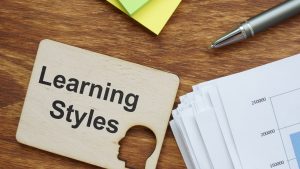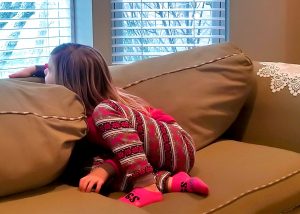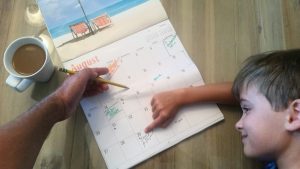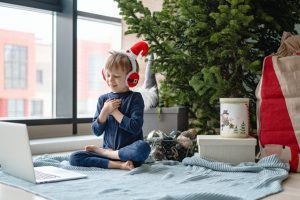Determining A Student’s Learning Style
If you have more than one child at home, you are likely aware of how different kids can be. There’s the shy kid, the messy kid, the chatty kid, the kid who’s into sports, the kid who sings, the kid who draws. Each child naturally connects to specific people, places, and activities, and these choices present as hobbies, interests, and skills. But being aware of your child’s interests can do more than help you choose the ideal curriculum, learning resources, or summer camps. When it comes to learning, you can also channel your child’s interests for the good of their education!
The first step is figuring out your child’s natural learning style. Identifying their learning style can help you plan meaningful activities with a lasting effect. Researchers have studied learning styles since the 1980s. The current VARK model stands for four types of learners: Visual, Auditory, Reading/Writing, and Kinesthetic (VARK). In more recent years, a few other learning styles have been identified, including the Socio-Emotional learner.
The VARK model is often used to improve lesson delivery and choose how best to teach and guide a child. Knowing your learning style is simply a general outline for making smart choices about how your child will learn best. Understanding your learning style includes knowing the methods, curriculums, and, yes, fun that will be the best format for your child to learn!
You can even plan family trips and adventures around these learning styles. Read on for tips and tricks for working with your child’s style.
What is a Kinesthetic Learner?
The “K” in VARK stands for kinesthetic. Kinesthetic learners are the doers of the four learning styles and learn best when physically interacting with their learning. These children benefit by “doing” and not just seeing or hearing. They need to get hands-on!
Does your kid touch everything? Do they have a hard time sitting still? Are they prone to deconstructing items to see how they work? These behaviors are common to kinesthetic learners because they require hands-on experience to learn. Sitting politely at a desk to study will not cut it for your doer! No matter the subject, kinesthetic learners grasp their learning through movement.
So what can you do? To start, let your child guide the way! There’s no need to fight your child’s natural interests; use them as sources of inspiration! Find projects and activities that play to your child’s strengths. While kinesthetic learners can learn by reading, seeing, and listening, they are likely to be most successful in situations that allow them to exercise their high-powered movement skills! Here are suggestions to consider when introducing or practicing concepts to suit your kinesthetic learner.
Instead of lengthy lectures, your child would benefit more from a role-playing exercise. Rather than paper-based math lessons, your kid will work better by getting hands-on with manipulatives. If you visit an art museum, you should expect your kid to want to get messy with paint shortly afterward!
Incorporate physical activity, like dancing, yoga, sculpting, and building, to keep a kinesthetic learner engaged and move meaningfully. Offer them the option to stand while working, fiddle with fidget tools, or use movement breaks to stretch out and refocus their energy. Using such techniques will keep them motivated to learn. You’ll be amazed at the difference in engagement when using the right tools for your child.
Supporting Kinesthetic Learners in Different Subjects
- English Language Arts: Up the engagement by bringing the page to the stage no matter what age! Have your child act out literary scenes or major plot points to work through them. Physical tools will be useful for spelling activities.
- STEM: Manipulatives will help your child to get physical with math concepts. Similarly, building models can be a great hands-on science activity. Remember, manipulatives aren’t just for the younger kids! Algebra tiles, chemistry kits, and other physical STEM tools are great for helping older children grasp tricky concepts! Don’t forget that microscope! Monthly learning kits and boxes are fantastic for kinesthetic learners. Let them get their hands “dirty.” Don’t forget to pull out the old “erector sets” for younger kids as well. Let their love of legos take over as they build everything!
- Social Studies: When appropriate, use role-play of historical characters and events to bring history to life. Your child will connect physically and emotionally when studying past perspectives. Dress up as characters, create clothing or build pyramids from clay. Advanced students can create complex structures to reflect on what they have learned. Miniatures showing battles and globes showing geography may also help. Gameschooling is a great alternative for kinesthetic learners as well.
- Social Activities: Kinesthetic learners are drawn to physical activities. It’s likely your kid is already invested in some sort of sport or dance! But also consider art classes like painting, clay sculpture, and more. Physical musical instruments like drums may also be a good fit.
Protip: You can find online classes for just about anything. You can also find music teachers and more on our site under professionals!
Supporting Other Learning Styles
While your child may naturally respond best to this learning style, it doesn’t mean other styles won’t be beneficial. Your kid may prefer a style, but children are incredibly adaptable. Aim to balance between supporting kinesthetic learning style and not limiting your child to it. Learning often happens through combining styles and other external factors.
An outing with their best friend or Grandma may also contribute to their willingness and ability to absorb the material. After all, kids are complex and follow their passions! That is the beauty of individualized learning and finding the right teaching methodology for your student. Guide and let them find their way.
Most importantly, listen to their feedback. Children will certainly let you know when you find the “right way” to learn. Having an open discussion about learning styles with children old enough to understand will also help them to guide you.
*These articles are meant to guide and for information purposes, and are not professional evaluations. For further analysis of your child or student’s learning style, consider an evaluation by a professional for further testing. Anything Academic can help you find both professionals and guides to testing for academics!













